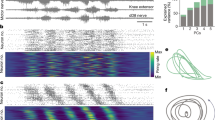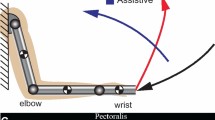Abstract.
We extend the analysis developed in the preceding paper in which we correlated kinematic parameters of planar movements of the human arm made by subjects moving to a visual target with numerical estimates of the ensemble encoding of muscle spindles within some of the muscles of this limb. Three possible models for the inclusion of noise in the calculations of the ensemble encodings are considered: (i) random errors in the angular coordinates from which muscle fascicle, and hence spindle length are calculated, (ii) variability of spindle discharge rates, and (iii) variability in the calculation of the ensemble encoding. In each case the correlations between kinematic variables of the movements and the resultant ensemble encodings decrease as the contribution of the noise term to the calculation of the encodings increases. Subject to the constraint that the magnitude of the noise term remains within physiologically realistic limits, however, the observed correlations persist at statistically significant levels. We also investigate the dependence of the observed correlations on the choice of model parameters, namely (i) the absolute and relative contributions made by simulated spindle primary and secondary afferents to the ensemble encoding, (ii) the inclusion of explicit length-related terms in the model of muscle spindle discharge, and (iii) the fractional power of velocity experienced by the model spindles during movement. The resulting correlations are approximately independent of both the fractional power of velocity and absolute firing levels of both the primary and secondary afferents of the spindle model. The inclusion of explicit length-dependent terms in the model does result in differences in the observed correlation coefficients. In this case, however, the magnitudes of the differences are small. On the basis of these findings we conclude that the correlations between kinematic variables of movement and the associated ensemble encodings are robust with regard to both the choice of model parameters and noise inherent at all stages of the transduction and processing of proprioceptive information. The findings of the present study provide further evidence, therefore, to support the hypothesis that motor structures capable of deriving such an ensemble encoding would be provided with information regarding ongoing movements in both intrinsic (body-centered) and extrinsic (Cartesian) coordinate systems.
Similar content being viewed by others
Author information
Authors and Affiliations
Additional information
Received: 17 November 1995 / Accepted in revised form: 17 June 1996
Rights and permissions
About this article
Cite this article
Wallace, K., Kerr, G. A numerical simulation of muscle spindle ensemble encoding during planar movement of the human arm: correlation sensitivity and parameter dependence . Biol Cybern 75, 351–359 (1996). https://doi.org/10.1007/s004220050301
Issue Date:
DOI: https://doi.org/10.1007/s004220050301




